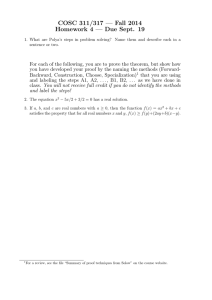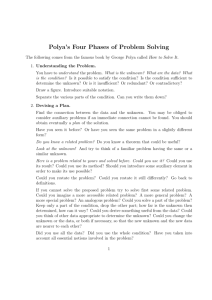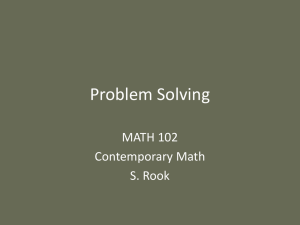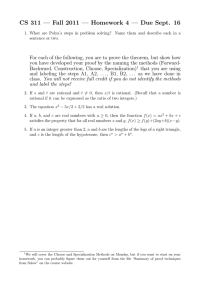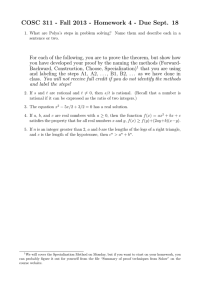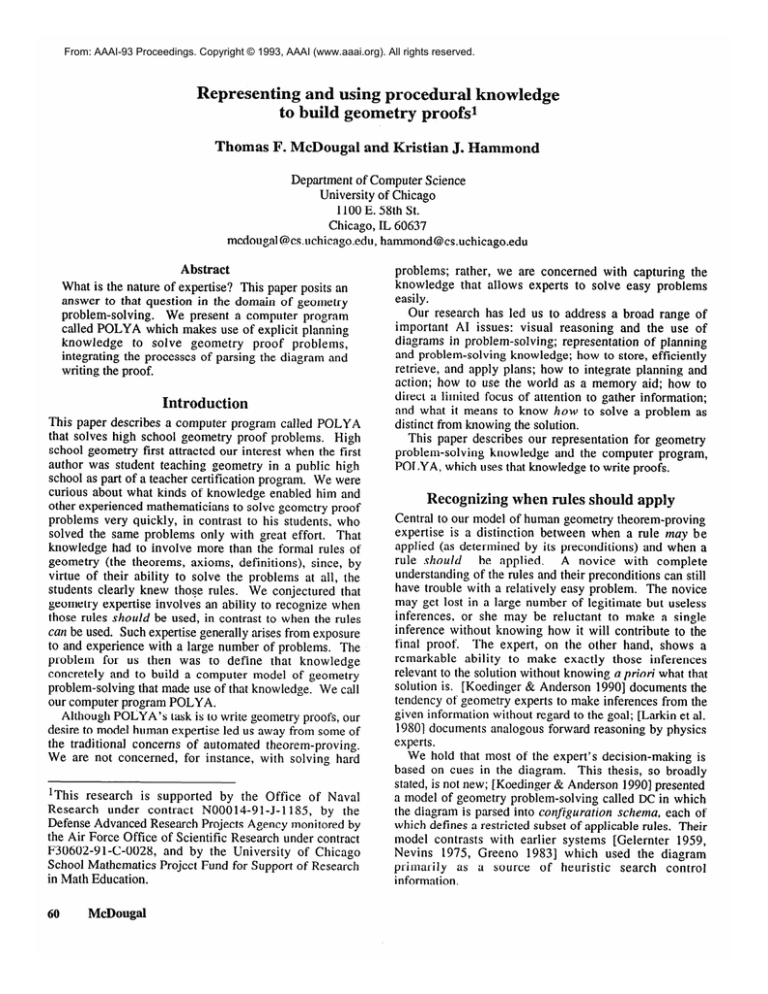
From: AAAI-93 Proceedings. Copyright © 1993, AAAI (www.aaai.org). All rights reserved.
Representing
and using
cedural knowledge
Thomas F. McDougal
Department of Computer Science
University of Chicago
1100 E. 58th St.
Chicago, IL 60637
mcdougal@cs.uchicago.edu,
hammond@cs.uchicago.edu
Abstract
What is the nature of expertise? This paper posits an
answer to that question in the domain of geometry
problem-solving.
We present a computer program
called POLYA which makes use of explicit planning
knowledge
to solve geometry
proof problems,
integrating the processes of parsing the diagram and
writing the proof.
Introduction
This paper describes a computer program called POLYA
that solves high school geometry proof problems.
High
school geometry first attracted our interest when the first
author was student teaching geometry in a public high
school as part of a teacher certification program. We were
curious about what kinds of knowledge enabled him and
other experienced mathematicians
to solve geometry proof
problems very quickly, in contrast to his students, who
solved the same problems only with great effort. That
knowledge had to involve more than the formal rules of
geometry (the theorems, axioms, definitions),
since, by
virtue of their ability to solve the problems at all, the
students clearly knew those rules. We conjectured
that
geometry expertise involves an ability to recognize when
those rules should be used, in contrast to when the rules
can be used. Such expertise generally arises from exposure
to and experience with a large number of problems.
The
problem
for us then was to define that knowledge
concretely and to build a computer model of geometry
problem-solving
that made use of that knowledge. We call
our computer program POLYA.
Although POLYA’s task is to write geometry proofs, our
desire to model human expertise led us away from some of
the traditional
concerns of automated theorem-proving.
We are not concerned,
for instance, with solving hard
lThis research
is supported
by the Office of Naval
Research
under contract
N00014-9 1 -J- 1185, by the
Defense Advanced Research Projects Agency monitored by
the Air Force Office of Scientific Research under contract
F30602-91-C-0028,
and by the University
of Chicago
School Mathematics Project Fund for Support of Research
in Math Education.
60
McDougal
problems;
rather, we are concerned
with capturing the
knowledge
that allows experts to solve easy problems
easily.
Our research has led us to address a broad range of
important
AI issues: visual reasoning
and the use of
diagrams in problem-solvin g; representation
of planning
and problem-solving
knowledge; how to store, efficiently
retrieve, and apply plans; how to integrate planning and
action; how to use the world as a memory aid; how to
direct a limited focus of attention to gather information;
and what it means to know how to solve a problem as
distinct from knowing the solution.
This paper describes our representation
for geometry
problem-solving
knowledge and the computer program,
POLYA, which uses that knowledge to write proofs.
Recognizing when rules shoul
Central to our model of human geometry theorem-proving
expertise is a distinction
between when a rule may be
applied (as determined by its preconditions)
and when a
rule should
be applied.
A novice with complete
understanding of the rules and their preconditions can still
have trouble with a relatively easy problem.
The novice
may get lost in a large number of legitimate but useless
inferences,
or she may be reluctant
to make a single
inference without knowing how it will contribute to the
final proof.
The expert, on the other hand, shows a
remarkable
ability to make exactly those inferences
relevant to the solution without knowing a priori what that
solution is. [Koedinger & Anderson 19901 documents the
tendency of geometry experts to make inferences from the
given information without regard to the goal; [Lax-kin et al.
19801 documents analogous forward reasoning by physics
experts.
We hold that most of the expert’s decision-making
is
based on cues in the diagram.
This thesis, so broadly
stated, is not new; [Koedinger & Anderson 19901 presented
a model of geometry problem-solving
called DC in which
the diagram is parsed into configuration
schema, each of
which defines a restricted subset of applicable rules. Their
model contrasts with earlier systems [Gelernter
1959,
Nevins 1975, Green0 19831 which used the diagram
primarily
as a source
of heuristic
search
control
information.
We believe that our model addresses two shortcomings
in the DC model.
First, while the DC model makes a
significant
contribution
in terms
of knowledge
representation
for geometry problem-solving,
it still says
very little about the problem-solving
process. The authors
note that once the diagram has been parsed, finding the
inference chain is trivial, which suggests that most, if not
all, of the problem-solving
task involves recognizing the
relevant schema.
Yet they consciously
side-step the
question of how people do this, with only a brief argument
that perhaps the diagram parsing and schema search
processes could be coordinated.
We also disagree
with DC’s model of schema
DC’s
configuration
schema
application.
Although
significantly
reduce the rule space, the model still falls
back on inference chaining to decide, for each schema,
which rule or rules should apply. The problem is that DC’s
schemas are overly general. Just as human experts are able
to commit to specific inferences
early in the problemsolving process, more specific schema would make it
possible to decide exactly which rule should apply without
a second phase of inference chaining.
In contrast, POLYA builds up the proof at the same time
that it builds up its understanding
of the diagram. It uses
schema-like knowledge to parse the diagram on demand,
and it recognizes
highly specific configurations
in the
diagram which enable it to make concrete inferences likely
to contribute to the final proof. The next sections provide
an overview
of POLYA’s
operation
and a detailed
description of its geometry problem-solving
knowledge.
An overview of POLYA
Figure 2: a triangle which appears isosceles. Angles 1
and 2 are the base angles. Angles 3 and 4 are marked
congruent,
as are two pairs of segments.
This
represents
the initial conditions
for one problem
POLYA can solve.
The input
As in textbooks, a geometry proof problem for POLYA
consists of givens, a goal, and a diagram. The givens and
goal are predicates such as (congruent-segments
(segment s
x) (segment t y)). The diagram is a composite of lines and
labelled points. Each line is defined by the coordinates of
its endpoints,
and labelled points are listed by their
coordinate locations, as: (x y <label>), where <label> is a
letter (A, B, etc.). The labels are irrelevant to the problemsolving process; they are used only to define the givens and
the goal and to generate the proof in human-readable
form.
Simulated vision
POLYA accesses the diagram by way of a simulated visual
system. The visual system provides over 120 operators by
which POLYA can specify which object or objects in the
diagram it wishes to inspect; the visual system returns a
description of that object including its exact location and a
list of aspects.
The operator
L 0 0 K-AT-LEFT-BASE-ANGLE,
for
example, takes as its argument the vertices of a triangle
which appears isosceles* and returns a description of one
of its base angles (e.g. angle 1 in figure 2).
That
description includes the (x, y) location of the vertex,
the compass directions
of the rays, a symbolic
description of the approximate size of the angle (e.g.
ACUTE>45),
a symbolic description of the pattern of
Simulated
rays at the vertex (SIMPLE-ANGLE),
a count of the
Plan memory
number of rays interior to the angle (zero), and, if
vision
there are no interior rays, a description of the space
unto which the angle opens (TRIANGLE).
The
Text &
description
also includes
whether the angle is
diagram
reter
marked (e.g. angles 3 and 4 in figure 2 are each
marked with SINGLE-ARC congruency marks).
actions &
POLYA can itself make annotations such as angle
predictions
marks
on the diagram.
There are several benefits
Ggure 1: POLYA’s three modules.
The plan interpreter sends
from
such
annotations.
Looking
at angles 3 and 4, it
commands to the vision module, which computes a description of
POLYA comprises
three basic modules:
a memory
retriever, a plan interpreter, and a module for simulated
vision (figure 1). The memory retriever takes a steady
stream of features and uses them to trigger plans in
memory. The plan interpreter selects a plan and executes
the steps in the plan. The vision module computes features
in response to the actions called for by the plan. The next
sections discuss these modules in detail.
some part of the problem and sends that description
memory module and back to the plan interpreter.
both to the
*Based on euclidean
distances between the vertices.
Case-Based Reasoning
61
Figure 3: POLYA can look at Zs to see if the angles are
congruent or the lines parallel.
is apparent from the marks that the angles are congruent to
Thus POLYA, like a person, need not
each other.
remember which angles are congruent, since it can always
oet that information
directly
from the diagram.
Furthermore, having a mark associated with an individual
angle streamlines some inferencing.
Looking at angles 3
and 5, POLYA can guess that angle 5 is probably
congruent to some other angle (angle 6).
In addition to angles, POLYA can focus on and describe
any of the visual objects involved in geometry proofs:
points, segments, triangles, quadrilaterals.
It can compare
pairs of objects-two
triangles, for example, or a segment
and an angle-to
see how they relate to each other
spatially.
When POLYA looks at a triangle, the visual
system
computes
its shape
(RIGHT,
ISOSCELES,
EQUILATERAL) and counts the number of sides and angles
annotated
with congruency
marks.
Thus marks on
segments and angles are reflected in the descriptions of all
larger objects which contain those segments or angles. So,
for example, POLYA can recognize when all sides of a
triangle are marked, suggesting
the applicability
of the
side-side-side
triangle congruency
theorem.
This is the
other benefit of angle and segment annotations.
POLYA can also look at composite shapes sometimes
mentioned in textbooks but never mentioned in proofs.
One textbook, for example, explicitly teaches students Z
and F patterns involving parallel lines cut by a transversal
[Rhoad, Whipple & Milauskas 19881. POLYA can look at
Zs to see if the angles are marked congruent or if the lines
are marked parallel (figure 3).
Operators
can sometimes
fail.
FIND-ADJACENTMARKED-ANGLE, for instance, can fail if no such angle
exists. Such operators are nonetheless useful for efficiently
locating objects of interest.
Geometry plans
To parse the diagram and write a proof concurrently,
POLYA needs to gather information in an organized way
while still responding flexibly to what it sees. POLYA has
a large memory of geometry plans which structure visual
search and instantiate
rules; plans are triggered
and
executed on the basis of configurations in the diagram.
A geometry plan defines a sequence of actions which
can be directly executed by the plan interpreter.
A typical
action looks like this:
((COMPARE-TRIANGLES
?tril
?tri2)
:predict (tri-pair
(extents
:unbind (?tril
?tri2)
:bind ?tri-pair)
62
McDougal
shared-side))
Figure 4: Two triangles share a side, and each triangle
has one side marked and one angle marked.
This
pattern triggers the P-SAS-SHARED-SIDE proof plan,
which checks that the marked angle is between the
marked side and the shared side.
isosceles.
The first item is an action for the visual system whose
The
arguments
are defined by local plan variables.
prediction partially specifies what the result of that action
should look like; if the result fails to match the prediction,
the plan aborts. A typical use of predictions is to check
preconditions of a rule. Each step may bind the result of
the action to a local plan variable and may unbind variables
no longer needed.
There are two types of plans: search plans and proof
plans.
Search plans direct the focus of attention to
potentially
relevant
parts of the diagram,
gathering
information
for the memory
module.
Proof plans
instantiate formal rules of geometry and add them to the
proof. Search and proof plans are structured and handled
in the same way, except that POLYA runs proof plans
preferentially.
(See plan selection, below.)
S-ISOSCELES3 is a typical search plan.
It directs
attention to the legs and base angles of a triangle which
looks isosceles. This reflects knowledge that if the triangle
is actually isosceles, the legs and base angles are more
likely to provide useful information,
and more likely to
play a role in the proof, than the apex angle or the base
side. P-SAS-SHARED-SIDE3 is a typical proof plan: if
POLYA detects two triangles each of which has one angle
marked and one side marked such that the triangles also
share a side (figure 4), the plan verifies that the angle
between the marked side and the shared side is marked,
then adds to the proof a statement that the triangles are
congruent.
Search plans gather features which trigger proof plans
and other search plans in an interacting
cycle of plan
selection and execution.
To build a proof for an easy-tomoderate geometry problem, POLYA may make use of 12
to 28 plans, causing between 50 to 120 actions to be
performed.
POLYA’s geometry plans define what it means to know
Once a plan has been
how to solve geometry problems.
triggered, execution is straightforward.
This is consistent
with our view of geometry problem-solving
as being
primarily a task of recognizing when a rule or other piece
3By convention, we use prefixes
search and proof plans.
S- and P- to distinguish
of knowledge
should apply.
Next we consider
POLYA recognizes which plans are relevant.
how
Plan memory and retrieval
We have said that plan execution generates visual results
In this section we
which in turn trigger other plans.
describe specifically how plans are triggered.
POLYA’s plan indexing scheme is based on the markerpassing scheme used in DMAP,
a case-based
natural
language understanding
system [Martin 19901. Each plan
has a plan index havin g two parts: an index pattern and
index constraints.
An index pattern consists of a sequence
of partially-specified
visual results. A typical index pattern
looks like this one for the P-SAS-SHARED-SIDE
proof plan:
( (triangle
(tri-pair
(angle-mark-count
1)
(seg-mark-count
1))
(extents
shared-side))
= (?2 triangle-l))
When the plan interpreter module finishes a plan, POLYA
chooses another from the list of triggered plans. Typically
there are several search plans to choose from, and perhaps
one proof plan. Proof plans are chosen ahead of search
plans, since after all the task is to write a proof; and plans
triggered more recently are chosen ahead of plans triggered
less recently. This plan-selection algorithm is too simple to
work in the long run, and we are experimenting
with ways
to incorporate knowledge about which plans should run
first.
In some cases one plan subsumes
another; by
annotating the larger plan we can ensure that POLYA runs
it and not the other.
Issues
)
This pattern detects a triangle with one marked side and
one marked angle, and a triangle pair sharing a side. The
index constraints specify that the triangle must be part of
the triangle pair:
( ((?l)
Plan selection
One of our objectives
with POLYA was to integrate
diagram parsing with the process of constructing a proof.
In so doing, we have had to address issues associated more
with planning,
robotics, and vision than with traditional
theorem-proving.
)
The memory module matches visual results against the
index pattern using DMAP’s marker-passing
scheme.
A
marker is placed on a node representing the first element of
the pattern. When a visual result matches that node, the
marker is advanced to the next element in the pattern.
When the last element has been matched, the plan is
triggered, posted to a list as eligible for execution.
We wish to emphasize that a plan index should not be
thought of as the antecedent of a rule. Relative to most
rules, plan indices are both over- and under-specified: overspecified in the sense that they seek to recognize not only
when a rule may be applied but when it shoulrl be applied;
under-specified
in that they do not always guarantee the
applicability of the rule. In the case of the P-SAS-SHAREDSIDE proof plan, for instance, the marked angle must lie
between the marked side and the shared side in each
triangle, a constraint which is not easily captured by the
raw descriptions
of the triangle and the triangle pair. It
would be possible to design the visual system to capture
that information as one aspect of the triangle pair. That
would subsume an important part of geometry knowledge
in the vision module.
We prefer, however, to represent
explicitly as much geometry knowledge as possible in the
plans.
As stated earlier, an important part of geometry er pertise
is the ability to make the inferences which are mosi likely
to contribute
to the final solution.
POLYA makes an
assumption which seems to work well for easy to medium
problems: If some features in the diagram cause a search
plan to focus attention on an object, then the object is likely
to be relevant to the proof. For the P-SAS-SHARED-SIDE
proof plan to be tri ggered, some other script must have
directed POLYA’s attention to the triangles. This does not
Ouarantee that it will be useful to prove the triangles
D
congruent, but it seems to be true most of the time.
laming
and action
POLYA treats planning as memory retrieval, in the spirit of
case-based planning [Hammond 19891. Because feature
extraction
is a major part of POLYA’s task, POLYA
cannot solve problems by retrieving and adapting a single
case, as a prototypical CBR system does. Instead, POLYA
accesses memory constantly, retrieving and using tens of
plans over the course of a single problem.
POLYA plans
and re-plans in response to what it sees.
This responsiveness to visual features is characteristic of
situated activity [Chapman & Agre 1986, Agre 19881. Yet
POLYA is not purely reactive;
its behavior
is better
characterized
as reactive
planning
[Firby 19891. It
executes each plan to completion so long as its predictions
are met.
The plans provide necessary
structure
for
apprehending complex relationships in the diagram and for
writing a formal mathematical argument. POLYA strikes a
balance between top-down memory-based
planning and
bottom-up reactivity.
Active
sensing
In the computer
vision community,
researchers
are
acknowledging that it is both intractable and unnecessary to
identify everything in an image [e.g. Ballard 1991, Clark &
Ferrier
1988, Swain 19911.
Particular
tasks require
attention to only particular aspects of the image. One may
be interested only in the object at the center of the image,
or one may be concerned only with detecting rapid motion.
Similarly,
a robot may have a ring of sonars, but for
moving forward across mostly-empty space it makes sense
to ignore the sonars pointing aft.
Geometry diagrams are simpler and more constrained
than an arbitrary image or a cluttered room, but the idea for
POLYA is the same: different parts of the diagram are
Case-Based Reasoning
63
relevant for different tasks, and some parts of the diagram
can be ignored altogether.
Furthermore,
we suspect that POLYA’s problem of
coordinating
multiple sensing operations
is relevant to
vision and robotics as well, and that the solution of using
short plans for information-gathering,
with top-down
predictions, may apply.
Example
Figure 2 above is one example of a problem POLYA can
solve. Here we show the diagram with all given information already marked on the diagram; one of the first
things POLYA does is annotate the diagram to reflect the
given information.
The goal in this problem is to prove
that the large triangle is isosceles, i.e. that its left and right
sides are congruent (have equal lengths).
At startup, POLYA computes a general description of
the diagram as a whole, capturing the left/right symmetry
of the diagram and the basic shape: a triangle with corner
triangles.
Two search plans are immediately
triggered
based on this description: S-ISOSCELES, described above,
and S-CORNER-TRIANGLES.
After marking the given information, POLYA executes
the S-CORNER-TRIANGLES
search plan, which focuses
attention on the corner triangles. The descriptions of those
triangles triggers S-SIDE+SIDE, which looks at angles 5 &
6 and at sides WX and YZ. The pattern of rays at the
vertex of angle 5 triggers S-PIER, which compares angle 5
with its adjacent angle, angle 3. Because angle 3 is
marked, plan P-LINEAR-PAIR-PAIR
is triggered, which
proves that angles 5 and 6 are congruent.
Shortly
thereafter, POLYA proves the corner triangles congruent
using P-SAS-SIMPLE,
which instantiates the side-angle-side
theorem.
At this point POLYA makes the equivalent of a leap of
A very specialized
plan, P-CORNERreasoning.
TRIANGLES->ISOSCELES,
is triggered by the combination
of the shape of the diagram (isosceles with comer triangles)
and the assertion that the triangles are congruent.4 Though
POLYA has not yet read the goal statement, this plan
represents the knowledge one might have from having seen
this problem before: the large triangle is almost certainly
isosceles,
and, furthermore,
that is probably
a key
conclusion
(though not necessarily
the goal) in this
problem.
The plan steps through the argument, adding
inferences to the proof: because the corner triangles are
congruent, the corner angles are congruent (1 and 2), and
therefore the sides of the large triangle are congruent.
Finally, POLYA reads the goal, discovering
that the
proof is complete.
Discussion
Theorem-proving
is usually done from scratch, using a
minimalist representation
of the problem and the rules. In
41nferences are passed to memory in the same way that
visual descriptions are, and can be used for indexing.
64
McDougal
light of that tradition, what POLYA does in the problem
above might seem like cheating.
In the foregoing example, POLYA makes use of two
and Pvery specialized
plans: S-CORNER-TRIANGLES
CORNER-TRIANGLES->ISOSCELES.
If we remove the PCORNER-TRIANGLES->ISOSCELES
proof
plan
from
memory, POLYA is still able to solve the problem, though
it takes longer.
(It cannot solve it without S-CORNERBut to remove that plan would be contrary
TRIANGLES.)
to the main point of this research.
The point is not to build a system which knows very
little but can solve problems by working very hard. That
has been done many times before. The point is to build a
system which knows a lot and which can solve problems
easily.
The point is to model what an expert knows,
including his memory of problems he has solved before.
This is what POLYA’s plans represent.
Conclusion
At current writing, POLYA has 68 search and proof plans.
These plans constitute POLYA’s knowledge about how to
solve geometry proof problems, covering roughly one-fifth
of the simple triangle congruence problems in a textbook
and a very few examples
involving
parallel
lines.
Expanding POLYA’s knowledge to cover quadrilaterals,
other parallel line examples, and other aspects of geometry
will at least double or treble the number of plans. Rapid
growth of plan memory is not a bad thing, provided that we
can continue to index the plans efficiently.
While many of POLYA’s
plans correspond
fairly
directly to general rules, some of POLYA’s plans relate to
specific problems in much the same way that a person
might remember a specific problem. We believe that it is
both necessary and appropriate
that geometry expertise
comprise knowledge at many levels of generality.
When
POLYA has a specific plan for a particular problem, fewer
plans are needed and fewer actions are performed
in
solving that problem. Thus it is the case with POLYA, as
with an expert, that the more knowledge it has, the more
easily it can solve problems.
References
Agre, P.E. 1988. The Dynamic Structure of Everyday Life.
Ph.D. diss., Artificial Intelligence Laboratory, MIT.
Ballard,
D. H. 1991.
Animate
vision.
Artificial
intelligence 48.
Chapman, D., and Agre, P.E. 1986. Abstract reasoning as
emergent from concrete activity.
In Reasoning about
Actions and Plans, Proceedings of the 1986 Workshop,
Timberline, Oregon, Georgeff, M.P., Lansky, A.L., eds.
Los Altos, CA.: Morgan-Kaufmann.
Clark, J. J. & Ferrier, N. J. 1988. Modal control of an
attentive
vision
system.
In Proceedings
of the
International Conference on Computer Vision.
Firby, R.J. 1989. Adaptive execution in complex dynamic
worlds. Ph.D. diss., Yale University.
Gelernter, H. 1959. Realization of a geometry theorem
In The Proceedings
of the
proving
machine.
International
Conference on Information Processing,
UNESCO, Reprinted in E.A. Feigenbaum & J. Feldman,
(Eds.) (1963), Computers and thought. McGraw-Hill.
Forms
of understanding
in
Greeno,
J.G.
1983.
mathematical
problem solving.
In Paris, S.G., Olson,
G.M., and Stevenson,
H.W., 1983.
Learning
and
Motivation in the Classroom. Erlbaum.
Hammond,
K. 1989.
Case-Based
Planning:
Viewing
Planning as a Memory Task. Academic Press, San
Diego,
CA , Vol. 1, Perspectives
in Artificial
Intelligence.
Koedinger,
K.R. and Anderson,
J.R. 1990.
Abstract
planning and perceptual chunks: Elements of expertise
in geometry. Cognitive Science 14:5 1 l-550.
Larkin, J.H., McDermot, J., Simon, D.P., and Simon, H.A.
1980.
Models of competence
in solving physics
problems. Cognitive Science 4~3 17-348.
Martin, C.E. 1990. Direct Memory Access Parsing. Ph.D.
diss., Yale University.
Nevins, A.J. 1975. Plane geometry theorem proving using
forward chaining. Artificial Intelligence 6.
Rhoad, R., Whipple,
R., and Milauskas,
G. 1988.
Geometry for enjoyment and challenge.
McDougal,
Littell.
Swain, M. J. 1991. Low resolution
cues for guiding
saccadic eye movements.
SPIE advances in intelligent
robot systems.
Case-Based Reasoning
65

